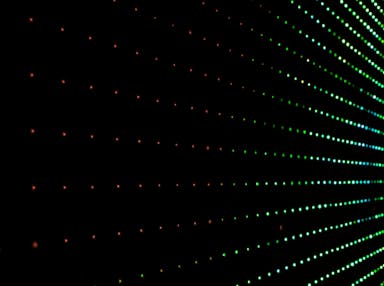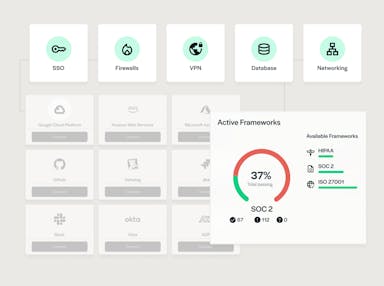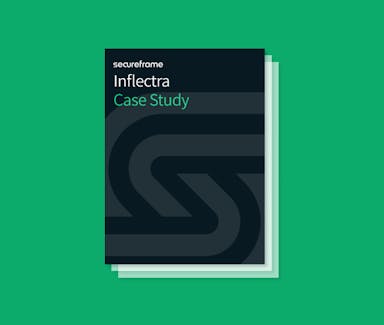
A Guide to Automated Evidence Collection for Compliance
Anna Fitzgerald
Senior Content Marketing Manager
Rob Gutierrez
Senior Cybersecurity and Compliance Manager, CISA, CCSK, CMMC RP
In 2023, almost 70% of service organizations said they need to demonstrate compliance or conformity to at least six frameworks spanning information security and data privacy taxonomies.
From information security frameworks like SOC 2 to data protection regulations like GDPR to industry-specific standards such as HIPAA, organizations are challenged with achieving and maintaining compliance with more and constantly evolving regulatory and customer requirements.
One critical aspect of compliance is evidence collection, which can become increasingly complex, time-consuming, and overall painful as a compliance program grows.
In this blog, we'll explain the traditional approach to evidence collection and how automation can solve common pain points that organizations face as they pursue compliance with multiple frameworks and undergo multiple audits. We’ll also provide tips for evaluating automated evidence collection solutions.
What is evidence collection for compliance?
Evidence collection for compliance entails gathering and documenting proof of adherence to framework requirements, such as screenshots, policy and procedure documents, security awareness completion certificates, configurations, code, documentation, communications, and more.
To understand the role of evidence collection in a compliance program, let’s walk through the typical approach to compliance.
A framework like PCI DSS or SOC 2® is broken down into key requirements. To achieve compliance, organizations need to implement a set of controls to satisfy all requirements that are relevant to their organization.
A control is a specific safeguard, like a policy, process, configuration, or tool, that an organization puts in place to comply with a framework requirement, protect its information assets, and manage risk. An organization typically implements a control set that includes a combination of management, physical, legal, operational, and technical safeguards to comply with all relevant framework requirements.
In the case of an internal or external audit, organizations must also provide evidence that they adhere to these requirements and that the controls they've put in place are operating as intended. This evidence may be collected manually in the form of screenshots, policy and procedure documents, security awareness completion certificates, organization charts, and tickets, among other types of evidence.
If using a compliance automation platform, the tool gathers this evidence through integrations and validates against controls and framework requirements via tests. Once you set up integrations with tools and applications that are being used across your organization, the automation platform will automatically collect evidence and map that evidence to framework requirements and controls via tests. These tests will be passing or failing to indicate the health of your controls.
During a compliance assessment, auditors will then evaluate the organization’s control set and evidence to make sure they are appropriate, effective, and meet framework requirements.
What evidence must be collected for compliance?
The exact evidence an organization must put in place varies according to the framework, audit, risks, interpretation of the framework requirement, or compliance automation tool they’re using.
For example, a typical SOC 2 audit will require documentation for business operations, HR, IT, privacy, and compliance. Some examples of each are listed in the table below.
| Type of documentation | Examples |
| Business Operations Documentation | - Diagram of your physical office - Corporate governance manual - Company Code of Conduct - Risk management plan - Compliance program budget - Vendor agreements - Business continuity and incident response plans |
|---|---|
| HR Documentation | - Organizational chart, plus outline of roles and responsibilities - Employee handbook - Onboarding documentation - Termination process documentation - Security training logs |
| IT & Technical Documentation | - Inventory of all devices on your network - Equipment maintenance records - Data retention and destruction policies - Encryption policy - Log management policy - Password requirements policy - Access policy and logs - System backup and update logs |
| Privacy Documentation | - Notice of privacy practices - Data use agreement - Unsubscribe and opt-out policies - Confidentiality policy and agreements |
| Compliance Documentation | - Previously completed compliance reports, if applicable - Risk assessments - Self-assessment questionnaires, if applicable - Penetration testing results, if applicable |
Now that we understand what evidence collection is, let’s look at how some organizations conduct this process, starting with the manual approach.
The challenges of manual evidence collection for compliance
Manual evidence collection for compliance involves human efforts to gather, organize, and document relevant information to demonstrate adherence to regulatory standards and framework requirements. This typically involves a combination of all or some of the activities below:
- Document reviews: This involves manually reviewing and collecting physical or digital documents, such as policies, procedures, contracts, and agreements, to ensure compliance with regulatory requirements. It often requires significant time and effort to gather and organize relevant documentation from various sources.
- Data entry: Manual data entry involves inputting compliance-related data into spreadsheets, databases, or other tracking systems. This method is prone to error and can be time-consuming, especially when dealing with large volumes of data.
- Interviews and surveys: This involves conducting interviews and surveys with employees, stakeholders, and third-party vendors to gather information about compliance practices, processes, and controls. While valuable for obtaining insights and feedback, this method relies on subjective responses and may not always provide comprehensive evidence of compliance.
- Ongoing communication with asset owners: Compliance is an extremely cross-functional practice, where the assets under scope typically span multiple teams across engineering, security, IT, and HR. That means the compliance team or project lead typically has to engage in a lot of back-and-forth communication with the teams that actually own the assets in question in order to complete the evidence collection process.
- Manual testing and audits: Performing manual tests and audits to assess compliance with regulatory requirements may involve conducting physical inspections, observations, and sample-based testing to verify compliance controls and processes. This can be time-intensive and costly.
- Email and communication tracking: This involves monitoring email communications and other forms of electronic correspondence to gather evidence of compliance-related activities, discussions, and decisions. This method requires manual review and analysis of communication channels to identify relevant evidence.
- Manual record-keeping: Maintaining manual records and logs of compliance-related activities, incidents, and exceptions requires diligent record-keeping practices to ensure the accuracy and completeness of compliance documentation.
- Manual remediation and follow-up: This involves addressing compliance issues and discrepancies identified through manual methods by implementing corrective actions and follow-up measures. This may involve manual tracking of remediation efforts and verification of their effectiveness.
While manual methods have been traditionally used for evidence collection for compliance, they are often labor-intensive, time-consuming, and prone to error. They also don’t scale well since organizations have to repeat the collection process again and again for every internal and/or external audit for the frameworks they comply with. Additionally, in the event of turnover, someone unfamiliar with compliance and/or the role may have to take over the manual process which would be a steep learning curve.
As a result, many organizations are increasingly turning to automated solutions to streamline the compliance process and ensure more efficient and accurate evidence collection.
Recommended reading

5 Hardest Things About Security Compliance and How Technology Can Help
What is automated evidence collection for compliance?
Automated evidence collection leverages technology to streamline the process of gathering, organizing, and managing all compliance-related documentation. Instead of relying on manual efforts, which can be time-consuming and error-prone, automated solutions use software to automatically collect evidence from various sources and consolidate it into a centralized format and repository.
Benefits of automated evidence collection
Let’s take a closer look at the major benefits of automated evidence collection below.
Enhanced efficiency
By automating the evidence collection process, organizations can save time and resources that would otherwise be spent on manual tasks, like data entry, conducting interviews, and monitoring email communication. Automated solutions can quickly gather evidence from multiple sources and environments, eliminating the need for repetitive and manual tasks like data entry and reconciliation.
Cost savings
Automation reduces the manual overhead of gathering evidence from all assets under scope in order to prove adherence to controls. This overhead not only applies to the compliance or GRC team, but also to engineering, security, IT, HR, and other teams that own the assets under scope. Combined, this results in significant costs to a business to prepare for their annual audits. By reducing the time and effort required for evidence collection, automation can help organizations lower operational costs and allocate resources more effectively.
Improved accuracy
Manual evidence collection is prone to human error, such as missing or incomplete documentation. Automated solutions reduce the risk of error by systematically collecting evidence according to predefined criteria and standards.
This provides peace of mind going into an audit. Auditors are required to do due diligence on every piece of evidence provided by the client to make sure that they feel completely comfortable with the evidence and ensure completeness and accuracy over it:
- The source of the data that was provided
- The reliability of the data to have been captured correctly and completely at the source
- The process for querying/generating the data for audit
- That the data didn’t get changed between being generated and being given to the auditor
- That the data is actually appropriate to test what the auditor is trying to test
An automated solution standardizes the evidence collection process and includes metadata such as where evidence comes from and when it was collected so auditors trust the quality and reliability of the data provided.
Greater scalability
As organizations grow and expand, the volume of compliance-related documentation also increases. Automated evidence collection can scale to accommodate growing data volumes and complexity, ensuring that organizations can maintain compliance without being burdened by manual processes.
Additionally, growing organizations also must prepare for annual (or more frequent) internal and/or external audits for a growing number of frameworks. By reducing the manual overhead of proving adherence to controls, automated evidence collection can significantly reduce the costs and efforts of managing a compliance program, even as the organization scales.
Real-time monitoring
Automated evidence collection solutions can continuously monitor controls and compliance-related activities and generate real-time reports and alerts if an issue is identified. This proactive approach enables organizations to identify and address compliance issues promptly, reducing the risk of non-compliance and reputational damage.
Recommended reading

7 Benefits of Continuous Monitoring & How Automation Can Maximize Impact
Tips for evaluating automated evidence collection solutions
Automated evidence collection offers numerous benefits for organizations striving to maintain compliance with regulatory standards and framework requirements.
By enhancing efficiency, accuracy, scalability, and real-time monitoring capabilities, automated solutions empower organizations to achieve and sustain compliance with confidence — but not all solutions are created equal. Use the questions below to help pick the right tool for your organization.
1. Evaluate the breadth of integrations
You want an automation platform that can act as a central place to track and hold evidence for your entire compliance program. So it’s important to look for a solution that offers out-of-the-box integrations with a wide range of tools and services commonly used in your organization. This ensures that the automated collection process can capture evidence from all sources relevant to your audit or compliance program.
2. Evaluate the depth of integrations
In addition to breadth of integrations, it’s critical to evaluate the depth of integrations offered by the solution. Many solutions offer a wide range of integrations but only pull in user data like names and emails. A solution with deep integrations will pull in all the compliance and audit-relevant data you need.
For example, say a solution offers an integration with an endpoint detection and response tool like Crowdstrike. If it just pulls in user data, that won’t be enough to satisfy compliance requirements. Instead, you want a solution that automatically pulls user endpoint inventory management, firewall management and enforcement, and other appropriate information from this EDR tool as you work towards compliance.
To evaluate depth of integrations, ask vendors the following two questions about the integrations you need:
- What do these integrations do?
- What data do they collect?
3. Assess the level of visibility into integrations
When using an automated evidence collection solution, you need context on its integrations. This is important for both your risk management and compliance program. Before connecting any integrations, you want to know what data is pulled, what permissions it has, and how it relates to other parts of your compliance stack, like controls and tests.
The best solutions will enable users to view all these details for any integration. With Secureframe, for example, you can click on any integration it supports and see:
- The type of access it requires
- The authentication type
- What data is pulled
- Which tests are supported by the integration
- Which controls are affected by the integration

4. Assess the solution’s export capabilities
One of the major benefits of an automated evidence collection solution is that it can continuously test your controls and alert you if there’s an issue so you can remediate it as quickly as possible. An ideal solution will make the remediation process as simple as possible.
Look for a tool that offers export capabilities. That way, if any of your tests fail, you can easily view and export the evidence collected or generated by those tests to remediate the issue. Some tools will go even further, highlighting the exact code in the raw evidence file that requires attention.
These capabilities can help speed up your remediation efforts so you can continuously maintain compliance and a strong security posture.
5. Consider a solution with an open API
It’s important for an automated evidence collection to offer a wide array of native integrations; however, it’s unlikely that it will have out-of-the-box integrations for every tool or service your organization uses now or in the future.
That’s the benefit of opting for an automated solution with an open API. An open API will allow customers to programmatically write and read data, to and from the evidence collection platform, so you can integrate with and pull evidence from any tool or service beyond its native integrations.
Choosing a solution with an open API therefore enables you to collect real-time data from your entire tech stack in one place for centralized compliance management and reporting. This is essential for growing organizations that will need an evidence collection tool that can scale with them and their evolving compliance needs.
Recommended reading

Introducing Secureframe API
How Secureframe’s automated evidence collection works
When asked what challenges led them to purchase Secureframe in a survey conducted by UserEvidence, 57% of Secureframe users reported a lack of a centralized, single source of truth in storing and managing security compliance data.
Secureframe can act as that central place to track and hold evidence for an organization’s entire compliance program.
Secureframe offers over 220 native integrations with the most popular applications across cloud services, identity providers, background checks, HR and people management, device management, developer tools, single sign on, and more — and the number continues to grow. For each of these integrations, Secureframe users can see tests and controls related to the integration, as well as the permissions and data pulled for the integration prior to connecting it.
In addition to its hundreds of out-of-the-box integrations, Secureframe has an API that can integrate with and pull evidence from any tool or service beyond those native integrations to ensure it can act as any organization's compliance source of truth.
Furthermore, Secureframe offers deep integrations to the tools and services your organization uses every day so that it's pulling in all the compliance data you need, not just user data like names and emails.
For example, Secureframe's integration with Crowdstrike goes deeper than user data and actually checks device security hygiene. This depth of integration is possible because Secureframe has its own integration builder that allows it to build integrations into any system for automated evidence collection and continuous control monitoring, rather than outsource this to a third-party integration broker. This way, Secureframe has ultimate control over the breadth and depth of integrations so it can be the compliance source of truth for any organization.
Once you set up integrations with tools and applications that are being used across your organization, the Secureframe platform will automatically collect evidence and map that evidence to framework requirements and controls via tests. These tests will be passing or failing to indicate the health of your controls.
You can easily download all evidence collected or generated by automated tests and operational tasks in bulk through the Secureframe data room, or individually for each framework and control. For any tests that are failing, you can view and export the raw JSON evidence. Secureframe will highlight the exact code that requires attention to help speed up remediation.
Users can also use Comply AI for Remediation to further speed up remediation. Comply AI automatically generates remediation guidance tailored to users’ environment so they can easily update the underlying issue causing the failing configuration in their environment. This enables them to fix failing controls to pass tests, get audit-ready faster, and improve their overall security and compliance posture.
Recommended reading

How Inflectra Saves 10 Hours a Month Maintaining Compliance Across its AWS Environments with Secureframe
Why customers choose Secureframe to automate evidence collection
Automated evidence collection is one of the most important features to Secureframe users, according to a survey conducted by UserEvidence. When asked to select the most important features, 79% selected automated evidence collection, making it the second top answer.
Evidence collection is just one of the many manual processes that Secureframe simplifies using automation and AI to reduce the time and efforts required for organizations to achieve and maintain compliance with global information security standards.
This feature, along with other automation capabilities, has helped Secureframe users unlock a range of benefits, including:
- 97% reduced time spent on compliance tasks per month, with 76% saying they reduced that time by at least half.
- 97% strengthened their security and compliance posture
- 95% saved time and resources obtaining and maintaining compliance
- 89% sped up time-to-compliance for multiple frameworks
- 85% unlocked annual cost savings
- 71% improved visibility into security and compliance posture
Ready to leave manual evidence collection behind and reduce the costs, inefficiencies, and human error associated with manual processes? Schedule a demo with one of our product experts to discuss Secureframe’s automated evidence collection and other capabilities today.
About the UserEvidence Survey
The data about Secureframe users was obtained through an online survey conducted by UserEvidence in February 2024. The survey included responses from 44 Secureframe users (the majority of whom were manager-level or above) across the information technology, consumer discretionary, industrials, financial, and healthcare industries.
FAQs
What is automated evidence collection?
Automated evidence collection uses technology to streamline the process of gathering, organizing, and managing all compliance-related documentation, rather than relying on manual efforts, which can be time-consuming and error-prone. This type of software automatically collects evidence from various sources and consolidates it into a centralized repository.
How does automated evidence collection differ from manual methods?
Automated evidence collection leverages technology to systematically gather and organize compliance-related documentation, whereas manual methods rely on human efforts for document reviews, data entry, and reconciliation.
How can I ensure the security of automated evidence collection?
Ask your vendor how they ensure the security of the data they collect. Secureframe, for example, employs robust security measures, including encryption, access controls, and regular audits, to ensure the confidentiality, integrity, and availability of customers’ compliance-related data.
Use trust to accelerate growth

Anna Fitzgerald
Senior Content Marketing Manager
Anna Fitzgerald is a digital and product marketing professional with nearly a decade of experience delivering high-quality content across highly regulated and technical industries, including healthcare, web development, and cybersecurity compliance. At Secureframe, she specializes in translating complex regulatory frameworks—such as CMMC, FedRAMP, NIST, and SOC 2—into practical resources that help organizations of all sizes and maturity levels meet evolving compliance requirements and improve their overall risk management strategy.

Rob Gutierrez
Senior Cybersecurity and Compliance Manager, CISA, CCSK, CMMC RP
Rob Gutierrez is an information security leader with nearly a decade of experience in GRC, IT audit, cybersecurity, FedRAMP, cloud, and supply chain assessments. As a former auditor and security consultant, Rob performed and managed CMMC, FedRAMP, FISMA, and other security and regulatory audits. At Secureframe, he’s helped hundreds of customers achieve compliance with federal and commercial frameworks, including NIST 800-171, NIST 800-53, FedRAMP, CMMC, SOC 2, and ISO 27001.